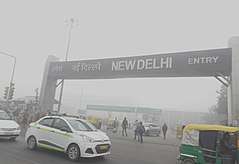Smog in Delhi
 Low visibility due to Smog at New Delhi railway station 31 December 2017. Railway building is not visible. | |
| Location | Delhi, India |
|---|---|
Smog in Delhi is an ongoing severe air-pollution event in New Delhi and adjoining areas in the National Capital Territory of India.[1] Air pollution in 2017 peaked on both PM 2.5 and PM 10 levels.[2] It has been reported as one of the worst levels of air quality in Delhi since 1999.[3]
Low visibility has resulted in accidents across the city, notably a 24 vehicle pile-up on the Yamuna Expressway.[4]
"The Great Smog" also led to cancellation and delay of public transport, primarily trains and flights, causing much hindrance to the people.[5]
Background
Source of pollution
The current majority of analysis sources are hinting towards colder weather, stagnant winds trapping the various sources of smoke. The primary sources of smoke are stubble burning, lit garbage, road dust, power plants, factories, and vehicles.
Air quality can be measured by the amount of PM 2.5 and PM 10 particulates suspended in air. On 7 November 2017 the PM 2.5 levels in Delhi shot up to an awfully high 999, much above the recommended 60 micrograms. At the same time PM 10 shot to 999 (the maximum level for the monitors), instead of the recommended limit of 100.[6]
Again on 8 November 2017 the PM 2.5 levels shot up to 449. At the same time PM 10 shot to 663.[7]
Weather
The temperature in New Delhi during this period was from 15 to 29 degrees C (~66 degrees F).
Incident
During the second day of third test of Sri Lankan cricket team in India in 2017-18 at Delhi, smog forced Sri Lanka cricketers to stop play and wear anti-pollution masks. Cricketer Lahiru Gamage reported to have shortness of breath.[8] Nic Pothas, coach of Sri Lankan cricket team, reported that cricketer Suranga Lakmal had vomited regularly due to severe pollution effect on the Delhi ground. There was a haltage of play between 12:32 pm to 12:49 pm which caused Indian coach Ravi Shastri to come out in an aggressive manner and have a talk with the field umpire David Boon.[9]
State reaction
A Health Emergency was declared in the capital by the Central Government of India in order to cope with the extrusive amount of polluted air. The day was declared as a holiday for schools, offices and other government centers.
Effects
Health effects
The government of Delhi has declared a health advisory.[3]
- Breathlessness
- Chest constriction
- Irritation in eyes
- Asthma
- Allergy
Control measures
The Chief Minister of Delhi at that time, Arvind Kejriwal, came out with the following proposed[10] action items to attempt to reduce the air pollution.
- All Delhi schools will remain shut for the next three days.
- For the next five days, no construction and demolition work will take place in Delhi.
- All diesel generator sets have been banned for the next ten days, except at hospitals and in emergencies.
- The Delhi government will supply power to unauthorized colonies which use diesel generators.
- The coal-based Badarpur power plant will be shut down for ten days. There will be no fly ash transportation from the power plant.
- The Environment Department will launch an app to monitor the burning of leaves.
- Vacuum cleaning of roads will start on 10 November.
- Water sprinkling will start on all roads from the next following days.
- People should stay at home as much as they can and they should try working from home.
It has been under public debate how much, if any, of the above steps actually help curtail pollution. Various bodies blamed various sources for the smog.
Longer term measures
On 25 November 2017, the Supreme Court of India banned the sale of firecrackers in Delhi to alleviate pollution.[11]
In another measure, the Badarpur power plant will remain shut until at least 31 January 2018.[12] This power plant is very old and polluting, and even before the Great Smog, environmentalists had advocated for its permanent shutdown.[13]
See also
References
- ↑ Sweta Goswami (7 November 2017). "Delhi's worst smog yet wakes up govt, emergency measures announced". Hindustan Times.
- ↑ Express Web Desk (2 November 2017). "Delhi wakes up to hazardous pollution levels, reduced visibility due to smog". Indian Express.
- 1 2 PTI (8 November 2017). "Delhi pollution: Government issues health advisory as smog chokes city". Hindustan Times.
- ↑ "Blinding Smog Causes 24-Vehicle Pile-Up On Expressway Near Delhi". NDTV.com. Retrieved 2017-11-09.
- ↑ "Delhi wakes up to dense smog; train services suspended due to low visibility". www.timesnownews.com. Times Now Bureau. 6 November 2017. Retrieved 2017-11-09.
- ↑ Express Web Desk (1 November 2017). "Diwali effect: Pollution worsens, particulate matter soars in Delhi". Indian Express.
- ↑ "Delhi Smog and band aid efforts to patch it". theindependent.in. 8 November 2017.
- ↑ "Pollution stops play at delhi test match as bowlers struggle to breathe".
- ↑ https://amp.sports.ndtv.com/india-vs-sri-lanka-2017-18/india-vs-sri-lanka-3rd-test-angry-ravi-shastri-marched-on-to-the-field-twitter-trolled-him-1783278?akamai-rum=off
- ↑ TNN (6 November 2016). "Air pollution: Delhi shuts schools, bans construction work". Times Of India.
- ↑ "Supreme Court bans sale of firecrackers in Delhi, NCR". Times of India. Retrieved 25 November 2016.
- ↑ "Badarpur thermal power plant to remain shut till Jan 31, 2017". Indian Express. 17 November 2016. Retrieved 25 November 2016.
- ↑ "The Badarpur Plant's Effect on Air Pollution and Why It Needs to Be Shut Down". The Economic Times. 12 August 2016. Retrieved 25 November 2016.